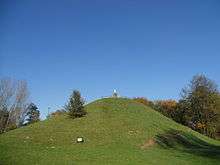Wanda Mound
Wanda Mound (Polish: Kopiec Wandy) is a tumulus located in Mogiła (since 1949 a neighbourhood of district Nowa Huta) in Kraków, Poland. The mound is assumed to be the resting place of the legendary princess Wanda. According to one version of the story, she committed suicide by drowning in the Vistula river to avoid unwanted marriage with a German. The mound is located close to the spot on the river bank where her body was found. Archaeological studies, conducted on site in 1913 and in mid-1960, did not provide any conclusive evidence of the mound's age or purpose.


The mound base, some 50 metres (164 ft) in diameter, is at 238 metres (781 ft) AMSL, and its height is 14 metres (46 ft).[1] Unlike the other three mounds in Kraków, this one is not located on a natural hill.[2]
The first written record of the mound comes from the 13th century. Within two kilometres (one mile) of the mound-site in 1225 a monastery was built by the bishop of Kraków, Iwo Odrowąż, called the Mogiła Abbey, which is still active today.[3] In 1860 it became a part of Austro-Hungarian fortifications, pulled down only in 1968-1970. In 1890 a monument designed by Jan Matejko was erected at the top: an eagle on a plinth decorated with a relief of a sword and a distaff, below the inscription "Wanda".
See also
- Krakus Mound, the legendary grave of Princess Wanda's father
- Kościuszko Mound in Kraków
- Piłsudski Mound, also in Kraków
References
- http://www.inyourpocket.com/krakow/Wandas-Mound_55715v
- Krakow Mounds, Kraków, Poland at Sacred Destinations, 2009
- "Krakow's Cistercian Abbey of Mogila". Marek Strzala. Retrieved 24 July 2013.
